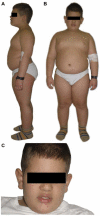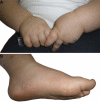Alström syndrome: genetics and clinical overview
- PMID: 22043170
- PMCID: PMC3137007
- DOI: 10.2174/138920211795677912
Alström syndrome: genetics and clinical overview
Abstract
Alström syndrome is a rare autosomal recessive genetic disorder characterized by cone-rod dystrophy, hearing loss, childhood truncal obesity, insulin resistance and hyperinsulinemia, type 2 diabetes, hypertriglyceridemia, short stature in adulthood, cardiomyopathy, and progressive pulmonary, hepatic, and renal dysfunction. Symptoms first appear in infancy and progressive development of multi-organ pathology leads to a reduced life expectancy. Variability in age of onset and severity of clinical symptoms, even within families, is likely due to genetic background.Alström syndrome is caused by mutations in ALMS1, a large gene comprised of 23 exons and coding for a protein of 4,169 amino acids. In general, ALMS1 gene defects include insertions, deletions, and nonsense mutations leading to protein truncations and found primarily in exons 8, 10 and 16. Multiple alternate splice forms exist. ALMS1 protein is found in centrosomes, basal bodies, and cytosol of all tissues affected by the disease. The identification of ALMS1 as a ciliary protein explains the range of observed phenotypes and their similarity to those of other ciliopathies such as Bardet-Biedl syndrome.Studies involving murine and cellular models of Alström syndrome have provided insight into the pathogenic mechanisms underlying obesity and type 2 diabetes, and other clinical problems. Ultimately, research into the pathogenesis of Alström syndrome should lead to better management and treatments for individuals, and have potentially important ramifications for other rare ciliopathies, as well as more common causes of obesity and diabetes, and other conditions common in the general population.
Keywords: ALMS1; Alström syndrome; ciliopathy; truncal obesity..
Figures



References
-
- Alström CH, Hallgren B, Nilsson LB, Åsander H. Retinal degeneration combined with obesity, diabetes mellitus and neurogenous deafness. A specific syndrome (not hitherto described) distinct from Laurence-Moon-Biedl syndrome. A clinical endocrinological and genetic examination based on a large pedigree. Acta Psychiatr. Neurol. Scand. Suppl. 1959;129:1–35. - PubMed
-
- Marshall JD, Paisey RB, Carey CM, MacDermott S. In: Gene Reviews [Internet], Seattle (WA): University of Washington, Seattle; 1993-2003. Pagon RA, Bird TC, Dolan CR, Stephens K, editors. 2010. [updated 2010 Jun 8].
-
- Marshall JD, Beck S, Maffei P, Naggert JK. Alström Syndrome. Eur. J. Hum. Genet. 2007;15:1193–1202. - PubMed
-
- Marshall JD, Bronson RT, Collin GB, Nordstrom AD, Maffei P, Paisey RB, Carey C, Macdermott S, Russell-Eggitt I, Shea SE, Davis J, Beck S, Shatirishvili G, Mihai CM, Hoeltzenbein M, Pozzan GB, Hopkinson I, Sicolo N, Naggert JK, Nishina PM. New Alström Syndrome phenotypes based on the evaluation of 182 cases. Arch. Intern. Med. 2005;165:675–683. - PubMed
-
- Collin GB, Marshall JD, Ikeda A, So WV, Russell-Eggitt I, Maffei P, Beck S, Boerkoel CF, Sicolo N, Martin M, Nishina PM, Naggert JK. Mutations in ALMS1 cause obesity, type 2 diabetes and neurosensory degeneration in Alström syndrome. Nat. Genet. 2002;31:74–78. - PubMed
Grants and funding
LinkOut - more resources
Full Text Sources
Other Literature Sources
